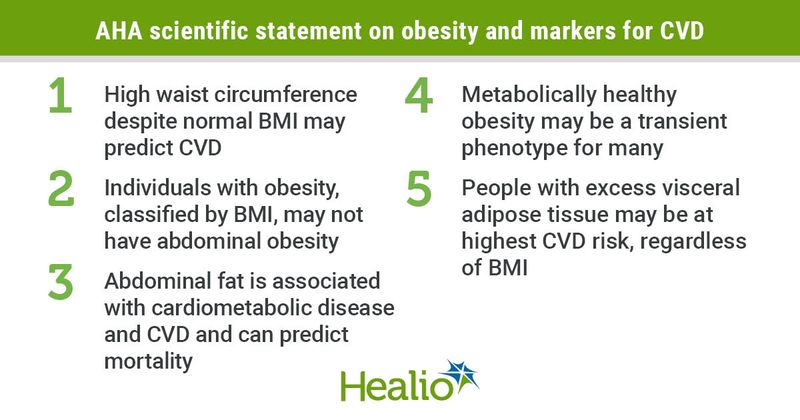AHA: Obesity ‘contributes significantly’ to global CVD burden, needs proper management
The obesity epidemic has played a major role in keeping heart disease the leading cause of death worldwide.
In a scientific statement published in Circulation, a committee assembled the latest clinical data aimed to inform practice regarding markers for CV outcomes in patients with obesity, lifestyle interventions and more.

“This scientific statement provides the most recent research and information on the relationship between obesity and obesity treatment in coronary heart disease, heart failure and arrhythmias,” Tiffany M. Powell-Wiley, MD, MPH, FAHA, a Stadtman tenure-track investigator and chief of the Social Determinants of Obesity and Cardiovascular Risk Laboratory in the division of intramural research at the NHLBI and chair of the writing committee, said in a press release. “The timing of this information is important because the obesity epidemic contributes significantly to the global burden of cardiovascular disease and numerous chronic health conditions that also impact heart disease.”
According to the statement, there is a relationship between overall obesity and abdominal obesity; however, individuals classified with overall obesity, classified by BMI, may not have abdominal obesity. Therefore, the committee posited that high waist circumference among individuals with normal weight may be a better predictor of CVD risk because it is also an indicator of abdominal body fat. Abdominal fat is associated with cardiometabolic disease and CVD and is predictive of mortality.
The statement referenced data that suggested metabolically healthy obesity may be a transient phenotype for many. Moreover, compared with individuals with metabolically healthy obesity, patients with excess visceral adipose tissue represent a subgroup of individuals at highest CVD risk, regardless of BMI.
“Epicardial adipose tissue represents visceral fat between the outer wall of the myocardium and the visceral layer of the pericardium,” the committee wrote. “This adipose tissue originates from embryonic brown adipose tissue and releases cytokines and chemokines into the vasculature. It has been associated with overall cardiovascular health score and arterial stiffness in patients with CVD and type 2 diabetes.”
Studies referenced in the statement found that epicardial adipose tissue thickness is associated with waist circumference, BP, markers of insulin resistance and dyslipidemia, and therefore may be an indicator of CV risk.
Weight loss and CAD in obesity
According to the statement, trials have shown that, in both men and women across varying ages, three to five exercise sessions per week for 12 to 52 weeks reduce visceral adipose tissue compared with no exercise. Additionally, reductions in visceral adipose tissue were achieved in the absence of weight loss. One meta-analysis of exercise interventions reported a 6.1% loss of visceral adipose tissue in the absence of weight loss.
Reductions in visceral adipose tissue with high-intensity exercise compared with moderate-intensity exercise is not always better, according to the statement, and 3 months of walking resulted in greater reductions compared with control. This finding suggests that current recommendations for physical activity (150 minutes per week) may be enough to reduce adipose tissue, with no further reductions with additional activity, the committee wrote.
According to the release, interventions that lead to weight loss improved CV risk factors; however, weight loss may not always lead to better outcomes in CAD.
A meta-analysis demonstrated that BMI in the overweight and obese ranges was associated with elevated CAD risk and at each level of BMI, whereas higher waist circumference and waist-to-hip ratio were associated with greater risk for CAD and CV mortality. These results were consistent for patients with normal weight as assessed by BMI.
“Lifestyle modification, with associated weight loss, improves both the diagnostic components of metabolic syndrome and associated pathophysiologic abnormalities such as systemic inflammation and endothelial dysfunction,” the committee wrote. “Interventional trials of medical weight loss have not demonstrated a clear reduction in CAD rates.”
However, the Swedish Obesity Study showed that patients who underwent bariatric surgery had reduced risk for CAD compare with nonsurgical methods of weight loss and lower rates of fatal and nonfatal CV events.
The committee stated that the reason for the disparate results between surgical and nonsurgical methods of weight loss was associated with the degree of weight loss achieved and the risk factor reduction observed among patients who underwent bariatric surgery.
Recommendations for future research
The committee made the following recommendations for future research in the area of obesity and CV health:
- Conduct randomized controlled trials that assess the role of weight loss and lower visceral adiposity in improving CVD outcomes.
- Develop dietary interventions with randomized controlled trials to determine healthful dietary patterns or personalized diets for patients with obesity for CV risk reduction.
- Develop upstream interventions for primary prevention and better treatment of obesity as a chronic disease among young patients.
- Identify best practices for use of GLP-1 receptor agonists and SGLT2 inhibitors to reduce HF hospitalization and CV death in HF with reduced ejection fraction and HF with preserved EF with and without diabetes.
- Develop strategies for weight maintenance and improved functional outcomes as opposed to weight-loss interventions in older populations at risk for HF.
“As overweight and obesity prevalence increases among adolescents worldwide, it is critical to address how best to develop upstream primary prevention interventions and better treatment strategies, particularly for young patients with severe obesity,” Powell-Wiley said in the release.
